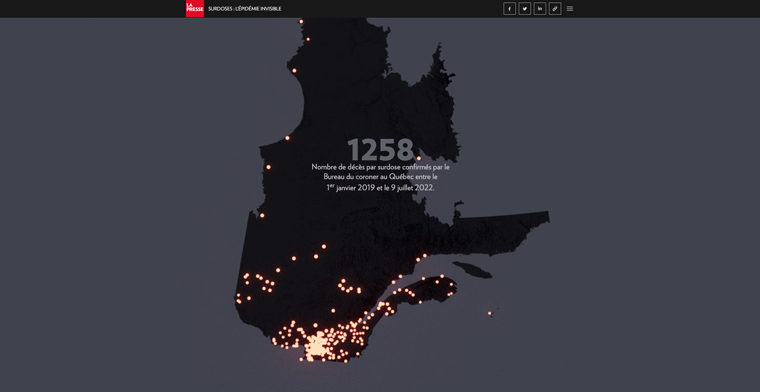La Presse takes on Quebec’s drug overdose problem with help from all departments
Ideas Blog | 21 May 2023
Drug overdoses kill more Quebecers than car accidents, yet we rarely hear about it. How can we draw attention to this major public health issue? We used a strategy that was unprecedented for us: We involved all departments of the company from start to finish.
At the beginning of the project, I gathered more than 20 people around the table. There were content directors, product managers, graphic designers, developers, our marketing specialists, the communications team, and people from business intelligence and marketing research.
Everyone listened intently as journalist Philippe Mercure described his project for a report titled “The Invisible Epidemic.” He never had such an audience to launch one of his stories. In front of him, everyone was fascinated to witness the genesis of a journalistic project.

In the last decade, La Presse succeeded in creating an exceptional ritual on its tablet application. Our daily edition is consulted on more than 248,500 digital tablets every day. Our readers spend an average of 40 minutes per day on the tablet during the week and around 50 minutes per day on the weekend. On our mobile app and Web site, engagement has never been at the same level.
We were convinced of the great potential of this story. However, the idea was to create a strong impact with our mobile app and Web site in addition to the tablet app. Could we also bring in such visual richness to increase reading time? And with our marketing communications team, can we make our subject matter radiate more than usual?
Finding the angle
Before we went into the field, we discussed the angle of the story. We wanted to show that drug overdoses affect people of all ages, from all social classes, and all over Quebec. The project’s designer, Maxime Jean, quickly began influencing the story. We had an idea of the beginning, and the skeleton of the chapters took shape. Our ideas were submitted in real-time to the project’s lead developer, Thomas Woodfine-MacPherson.
In parallel, we planned an intense two-month marketing campaign that included, among other things, newsletters, social media, advertising, and notifications. This digital story was published on October 22, 2022. Portraits of overdose victims were then published until mid-December.

Both in form and scope, this story differed from those we usually publish. It featured intricate storytelling using data visualisation, animation, stunning photography, and compelling text.
More than 350,000 people have viewed our story. The average reading time was 15 minutes, and follow-up articles totalled about 3 million opens. These are still leading to the main story being opened. Our report led to interest from several competing media organisations, and Mercure was interviewed about 10 times on radio and TV.
Reaching goals
We achieved our main objectives: to draw attention to an important subject, to get a high reading time on the Web and mobile, and to give a breath of fresh air to a subject for several weeks.
But beyond the numbers, our readers emphasised the great compassion and thoroughness of our reporting. A relative of a victim wrote us: “You are doing a great job on a subject that will leave a mark and hopefully a continuity in your efforts for a better society. Thank you for your compassionate approach and for keeping the memory of those who have lost us, leaving a great void of love, alive.”
On average, Quebec is home to 1.5 fatal overdoses every day. Our biggest wish with this report is to overcome our prejudices and see what they lead to: preventable deaths that strike people like us.































